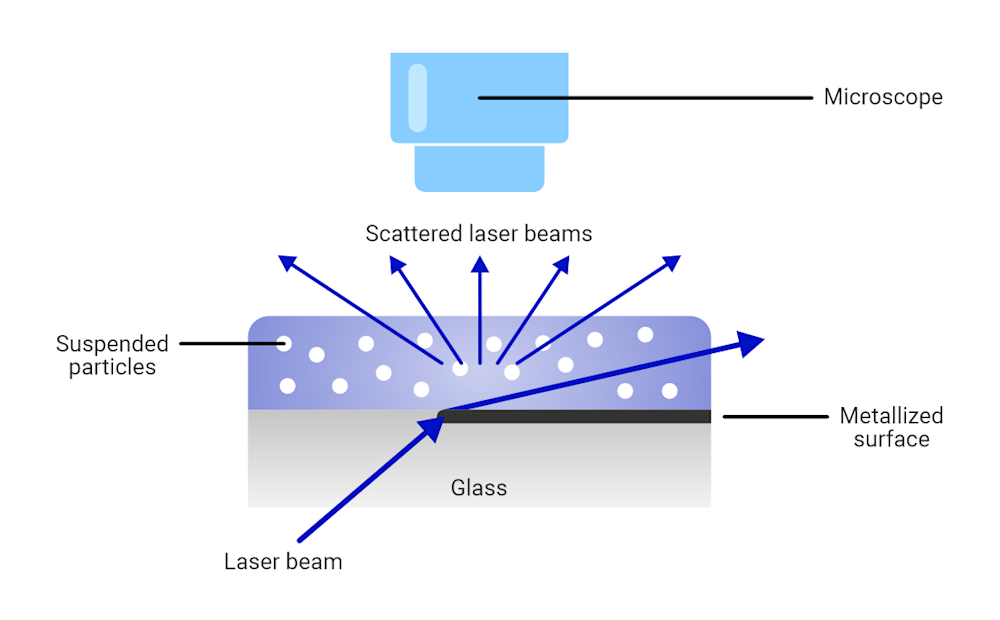Nanoparticle tracking analysis
Nanoparticle tracking analysis (NTA) is a form of particle tracking analysis (PTA) that measures the movements of nano-sized particles to visualize them and analyze their physical properties, such as particle size and distribution.

- Fast turnaround times
- Personal service from method experts
- Competitive prices
- Result accuracy guarantee
What is nanoparticle tracking analysis used for?
NTA is used to characterize particles within the particle size range of ~10 nm to ~1 µm. It is commonly used in drug-delivery studies, microbial analysis, toxicology, and viral studies, as well as industrial nanoparticle development and polymer research.
Another application of nanoparticle tracking analysis is the detection and characterization of nanoparticles in food and water samples. It is one of the methods mentioned in the European Food Safety Authority’s (EFSA) guidelines for determining whether food materials contain nanoparticles, although electron microscopy (SEM or TEM) is used more often.
How does nanoparticle tracking analysis work?
NTA works by illuminating the sample with a laser. The motions of the particles within the sample cause the light to be partially scattered, which is monitored using a microscope. A video of this process is recorded, which shows the Brownian motion of the particles over time. This provides a visual representation of the particles. The tracking of particles can also be used to calculate the particle size distribution within the sample.

Sample requirements and preparation
NTA is typically carried out on samples consisting of particles within a suspension, meaning in most cases there is minimal preparation required. NTA can be carried out on suspensions with even a relatively low concentration of detectable particles, provided that the particles are bigger than ~10 nm and smaller than ~1 µm.
NTA vs DLS
Dynamic light scattering (DLS) is a similar technique that measures scattered light from a laser to determine particle sizes in solution. The key difference is that DLS takes a snapshot of the sample, meaning that all of the particles are measured at the same time. This makes it faster than NTA for characterizing a solution and determining the average particle size, making DLS more appropriate for monodisperse samples. This also makes DLS more suitable for measuring larger nanoparticles than NTA.
NTA, on the other hand, is more suitable for characterizing polydisperse samples and gathering size-distribution information. Ultimately, both methods have complementary attributes and can sometimes be used in conjunction to gather a full set of data.
Need particle analyses?
Measurlabs offers laboratory tests for particle characterization with NTA and other methods, such as DLS. From tens to hundreds of samples, we ensure your analyses are handled on time, with the highest quality. More than 700 companies have chosen Measurlabs for accurate results and dependable service - contact us through the form below to get a quote and experience our service level yourself.
Suitable sample matrices
- Food and water samples with nanoparticle suspensions, including microplastics
- Liposomes
- Micelles
- Metallic nanoparticles in suspension form
- Polymeric nanoparticle suspensions
Ideal uses of NTA
- Detecting nanoparticles in food and water samples
- Calculating the size distribution of polymer particles
- Analyzing aggregate suspensions
- Toxicology studies
Ask for an offer
Fill in the form, and we'll reply in one business day.
Have questions or need help? Email us at info@measurlabs.com or call our sales team.
Frequently asked questions
Measurlabs offers a variety of laboratory analyses for product developers and quality managers. We perform some of the analyses in our own lab, but mostly we outsource them to carefully selected partner laboratories. This way we can send each sample to the lab that is best suited for the purpose, and offer high-quality analyses with more than a thousand different methods to our clients.
When you contact us through our contact form or by email, one of our specialists will take ownership of your case and answer your query. You get an offer with all the necessary details about the analysis, and can send your samples to the indicated address. We will then take care of sending your samples to the correct laboratories and write a clear report on the results for you.
Samples are usually delivered to our laboratory via courier. Contact us for further details before sending samples.